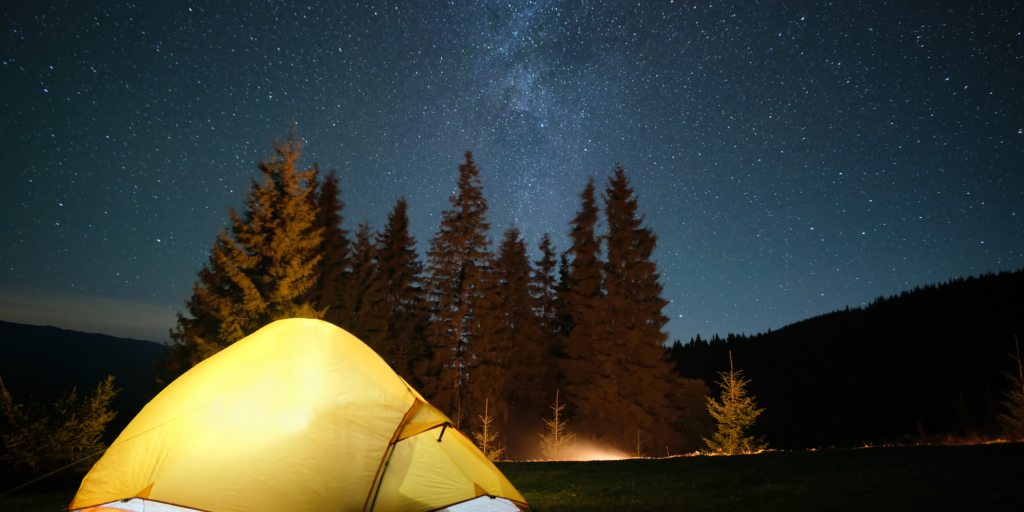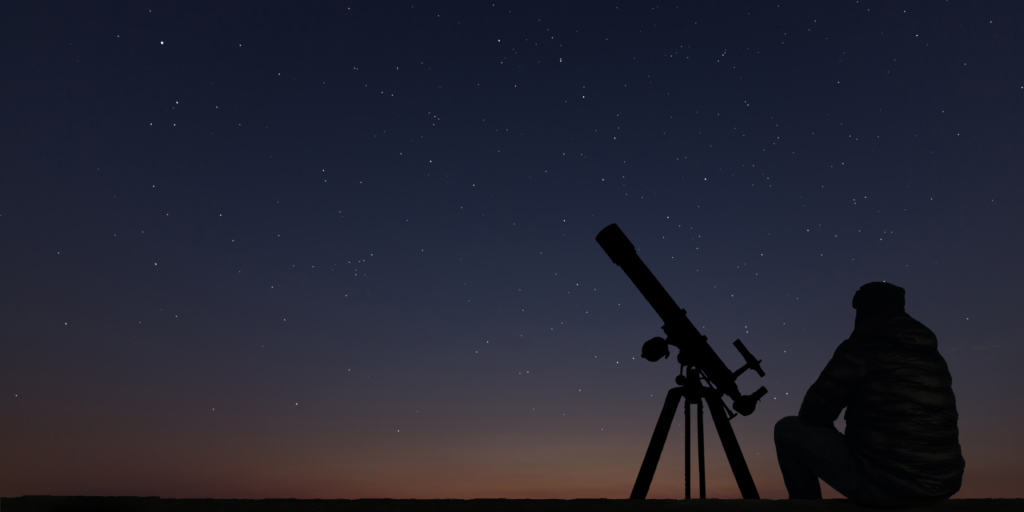On the night of 12-13 August, the so-called night of shooting starsalthough no stars actually fall from the sky. Well, what do we actually see every year in the August sky? And are shooting stars and the Perseids the same thing? We asked Karol Wojcicki about this - astronomy populariser, night sky enthusiast and creator of the largest astronomy fanpage in Poland, "With your head in the stars" on Facebook. We will also show you the best places for stargazing, away from the city lights and surrounded by Nature. If you can't make the trip at that time, at the end you will find a link to Karol's broadcast, who will be transmitting directly from the Bieszczady Mountains.
What are shooting stars?
We should professionally refer to the Perseids as meteorsare phenomena in the upper atmosphere caused by the passage through it of particles of matter no larger than a grain of sand, which fly at very high speeds of up to 70 km/s. This causes very high friction and high temperatures, resulting in their combustion and the glowing of the air along their flight path. This causes a very high friction force and the generation of high temperatures, resulting in their combustion and the glowing of the air along the route of these particles. This phenomenon is perceived by us from the ground as a short, quick flash of a shooting star, although in reality, no stars are missing from our sky.
It can also happen that a larger "crumb" enters the atmosphere, survives its passage through it and falls to earth in the form of a small rock crumb, which we then call a meteorite. So we have a meteor, which is a phenomenon that occurs high in the atmosphere and meteorites that is, the residue from such phenomena that can sometimes reach the Earth's surface.
Although stars 'fall' every night, we can only look out for their greater intensity on certain nights of the year, when we are confronted with so-called meteor swarms. Perseids this is one such swarm.
Why are the Perseids so special?
The increased activity of shooting stars is associated with so-called meteor swarms. At this time, the Earth as it travels around the Sun in the Solar System crosses the orbits of icy comets on its route. These are large dust-covered lumps which, as they approach the sun, heat up and the ice covering them begins to sublimate (i.e. change from a solid state directly into a gas). During this process, large amounts of gas are released, which also picks up dust from the comet's surface, which is why the comet has two pigtails - one gaseous and the other dusty, which is always laid out along the comet's transit path. Therefore, such a comet can be compared to the proverbial Grzes, who walked through the countryside with a sack of sand and left a trail behind him. Comets do exactly the same thing, and the Earth, as it makes its way through such a trail, is bombarded with large amounts of dust particles left behind by comets.
For this reason, we may see far more of these meteor phenomena then than on any other night. And due to the fact that the meteors seem to fly out of one area in the sky, a given swarm is named after the constellation from which it seems to radiate, fly out. The Perseids fly out of the constellation Perseus hence their namebut we also have in the sky leonidsthat fly out of the constellation of the lion (Leo in Latin) or geminids, which fly out of the Twins (the Latin for twins is Gemini).
I would also add that the Perseids are not the biggest meteor swarm as you might think, although they are among the biggest three. It's certainly the most famous because it's also the easiest to observe - in summer, when the nights are short and warm, it's easier and more enjoyable to go out for all-night observing and spend a few hours lying down under the sky. This is much harder to do with the December Geminids or the January Quadrantids, whose activity is somewhat greater. Well, but not everyone will want to lie in the snow at -10 degrees. Hence, it is the Perseids that are so infamous and indeed everyone likes to observe them.
When to look out for the Perseids and in what area of the sky to look for them?
Throughout August, we can look for shooting stars in the sky, while will culminate on the night of 12-13 August. As mentioned earlier, meteors from the Perseid swarm fly out of the constellation Perseus - a typically autumnal constellation that appears in the second half of summer low over the eastern horizon In the first half of the night. Successively, it slowly ascends, reaching a very high part of the sky before dawn. Accordingly, in the first half of the night it is indeed best to keep an eye on the eastern horizonas this is where we will probably see the most of these meteors.
It is worth remembering that during the first half of the night, due to the low position of the constellation Perseus, there will be slightly fewer meteors than we might expect. Only in in the second half of the night, around one or two o'clock in the morning, you can look up and see as much of the sky as possible while lying down.. Although meteors will be flying out of Perseus, it is not the best idea to look exactly there, as meteors will be flying in various corners of the sky. So there is nothing left for us to do but to simply be vigilant and cover as much of the sky as possible with our eyes, then we will increase our chances of spotting a shooting star.

How do we prepare for observing? Do we need a telescope?

Meteors are perhaps that most enjoyable branch of astronomical observation to which the we do not need any optical instruments. Admittedly, there are some methods, but they are reserved for professional or semi-professional astronomers. To see meteors, we simply need our eyes and nothing else.
Staring at the sky for long periods of time, especially when standing, can give us back or neck pain very quickly, especially if we pull our head down hard. Therefore, the best solution is to take care of a suitably comfortable lying or semi-lying position, So some blanket, mattress, folding deckchair or even a beach chair will allow us to observe the sky much more comfortably. Because we have to remember that the meteors, although they will be flying all night long, not in such numbers that after a single glance at the sky we will be saturated with their view. It will be necessary to devote at least several tens of minutes, and preferably several hours, and then the semi-recumbent position will certainly help us to do so.
Let's also remember that August nights can already be cold, so they can come in handy warm clothes, a hat and even sometimes gloves. Lying in one position for a long time, even if the night is not particularly cold, can simply make us cold. It is also worth having something against mosquitoesbecause these can make their presence felt. And above all thermos of warm tea or coffee should help us to stay awake, because staring at the stars in a semi-reclined position, wrapped in a blanket and crickets playing, we can quickly drift off into the arms of Morpheus, and the stars will then only remain a dream, not a pleasant memory.
Astrophotography, or how to capture shooting stars in a photograph

Taking a picture of a shooting star is not easy and you have to do a bit of thinking, because remember that it appears for a fraction of a second. Therefore, we will not know where to aim, when to press the shutter button and which parameters will be best to capture this one shooting star. The best solution is to set photo trap, which is a camera that will constantly look up at the sky, taking a series of photographs so that when something in the sky appears, you believe it.
In the case of shooting stars, we only have one chance, a fraction of a second, and therefore the camera should be set up on a fixed tripod with serial exposures one after the other. It's a good idea to keep the exposures reasonably short up to 5 seconds or so, while keeping the sensitivity (ISO) very high so that a shooting star that appears in such a short period of time can get properly exposed in the photo. This is not easy and can be frustrating, so if you are not very good at photography, you can relax and sooner or later you will find pictures of a shooting star on the Internet.
Where is the best place to watch shooting stars?
The basic prerequisite for observing the night sky is... good weather. If there is a thick layer of clouds hanging over our heads, it is unlikely to be a successful observation.
In addition, there is a saying that it is darkest under the lantern, but it is total nonsense from an astronomical point of view. The bane of astrologers is the so-called light pollutionThis means that the sky is excessively illuminated by artificial lights in the city. Therefore, the further away we are from the city and the lights, the darker the sky we will see above our heads, and thus our chances of spotting a shooting star will increase.
If we want to see a meteor shower, best to escape somewhere in natureOutside the city, in the countryside, in a meadow or in the mountains. These places, which are characterised by a much lower degree of illumination of the night sky, are a much better place for astronomical observations.

Karol's broadcast from Bieszczady
If anyone is interested in more interesting stuff, the we recommend Charles' astronomy Facebook "With head in the stars", where he gives an ongoing account of the various phenomena happening over our heads.
You can also watch the astronomical phenomena there during the live broadcast. If someone on 12 August does not have the right weather conditions to admire the shooting stars, they can try their luck with Karol - perhaps they will be luckier and, using a satellite link, he will broadcast a live view of the shooting stars from the Bieszczady Mountains directly to the Smartphones and computers of those following 'With your head in the stars' on Facebook and YouTube.
We have prepared a list for you of places where, weather permitting, a rain of shooting stars will appear over your heads.
Bieszczady
It is one of the darkest places in Poland, with minimal light pollution. The starry sky of the Bieszczady Mountains can be additionally admired thanks to the Starry Sky Park, created as part of a Polish-Slovak educational, scientific and tourism project.
Where to sleep in the Bieszczady?

Masuria
The Land of a Thousand Lakes is also a region with minimal light pollution and beautiful landscapes. Many open spaces, lots of lakes and clear skies make Masuria the ideal place for Perseid sightings.
Where to sleep in the Masuria region?

Polesie
This region of eastern Poland is known for its numerous lakes, marshes and forests. It offers exceptional conditions for astrotourism. Polesie is characterised by a magnificent night landscape, which allows you to admire the sky in all its glory.
Where to sleep in Polesie?

Drawsko Plain
Located in north-western Poland, the wide and open spaces make it an excellent place for meteor watching. The Drawsko Landscape Park and the Drawa National Park are nearby, offering a peaceful and secluded environment to admire the Perseids.
Where to sleep in the West Pomeranian region?

Sudetes, Jizera Mountains
This region is famous for having some of the darkest skies in Poland, making it an ideal location for Perseid sightings.
Where to sleep in the Jizera?

Karol Wojcicki -
With head in the stars
Night sky enthusiast and photographer, populariser of astronomy, science journalist. Creator of the largest astronomy fanpage in Poland ".With head in the stars" on Facebook.
He travels the world in pursuit of solar eclipses and spends two months a year behind the Arctic Circle, hunting for the aurorae. At the same time, from his backyard observatory he brings the Universe closer to the hundreds of thousands of people who follow him online.

He has made infecting his passion for astronomy a way of life. He has organised some of the world's largest joint observations of the night sky and many other popular science events. He is a frequent guest on television and radio programmes.
He has hosted popular science programmes on Discovery Science and TVN channels, among others. Over the years, he has collaborated with numerous planetariums and science centres across Poland. Currently, he is discovering the beauty of unique astronomical phenomena around the world as part of his One Small Step popular science expeditions.
Winner of the Populizer of Science 2015 prize awarded by the Ministry of Science and Higher Education and the Polish Press Agency.
